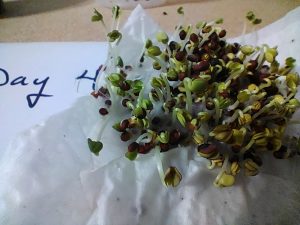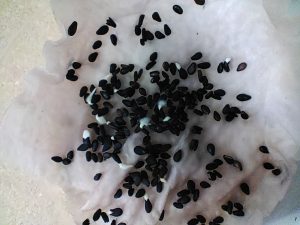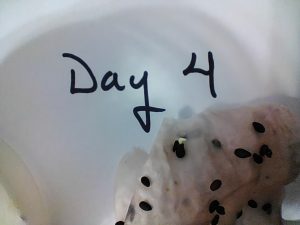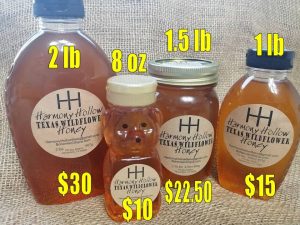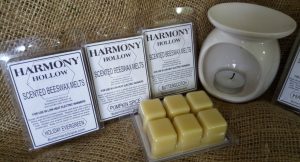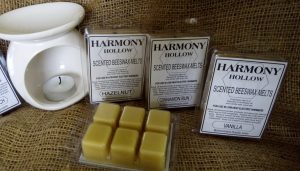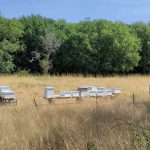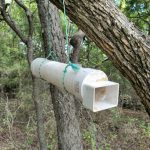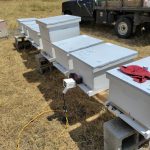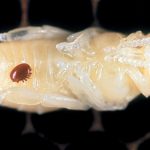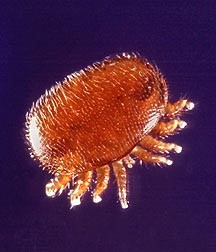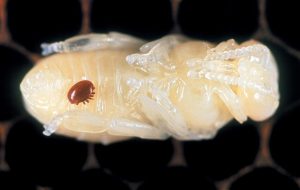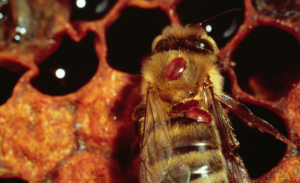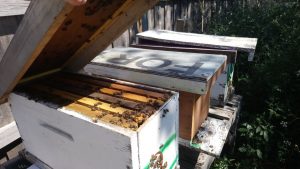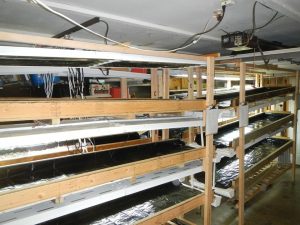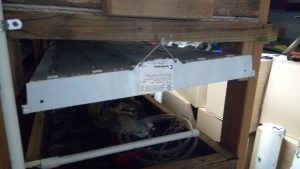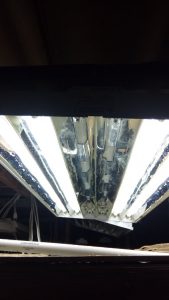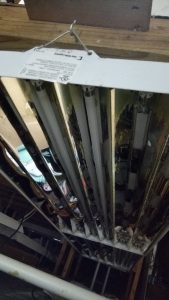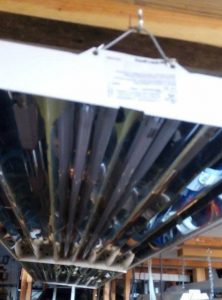|
||||||
|
This winter I am planning to add seeds to several bee yards. I encourage every property owner that I manage bees for – to plant wildflower seeds to promote forage to help the bees. In locations where no additional seeding has been offered to the Earth, I am doing some tests – with a goal of feeding manually to a much lesser degree than in the past. I bought bulks cooking seeds from an Indian grocery store – where many spices and herbs come as bulk seeds – and are affordable. Enjoy the video where I start germination tests on Mustard seed, Dill, Sesame (Brown and Black), and black peppers – on this time around. Come to Yoga Art Music (YAM Dallas) this coming Saturday for their Small Business Saturday from 1pm-5pm to get your Holiday honey and support several small local businesses. We will be at: As a bonus – if you are a prior Harmony Hollow customer, and have glass honey jars that you’d like to recycle – bring them in with you for a $1 credit ea towards your next honey purchase. (must be a Harmony Hollow labeled pint or quart jar)
It is now July of 2022, and Varroa Destructor mites have been detected in Australia. The beekeepers there have long enjoyed their vocation (and hobby) of beekeeping without this pest, which is a known transmission vector for at least 27 destructive viruses. Australia’s Department of Primary Industries current action plan is to eradicate the varroa – by eradicating the food upon which they feed. That means that the bee colonies – both managed and feral – in the know contamination zones – will be destroyed to destroy the pest. My understanding is that honey harvests, equipment, and bees – all will be destroyed in an attempt to give their continent a clean slate again. Varroa feed upon the hemoglyph (fat bodies) within the body of the bee (and other pollinators as well). Their reproductive cycle – occurs in the cell of a honeybee larvae – as it pupates. An excerpt from the USDA states:
When they were detected in the US in 1986 – after being found first in Mexico and Canada, the destruction to colonies was massive. Entire operations lost to disease being transferred from these pests. In other parts of the world, we have learned to deal with varroa with several methods. Chemical, Environmental, and Genetic shifts are currently being employed. Of these – so far – there is no “Magic Bullet” that eradicates the mite completely… Chemical treatments may include: (but no limited to) Apivar , ApiGuard, Formic Acid (Formic Pro, etc) , Oxalic Acid in various forms (liquid drizzle, vaporized gas, blended with glycerine onto sheets, etc. Environmental changes include heat / thermal treatments of the brood space of the colonies. Products such as the “Bee Hive Thermal Industries” – Mighty Mite Thermal Treatment uses a heat plate to raise the internal hive temperature to 106 deg F – which has been proven to sterilize mites so they cannot reproduce. This done on a regimen of several treatment periods spaced 5 days apart – can interrupt the life cycle of the varroa. This method was employed after observation of the natural brood break cycles that occur when a colony swarms. During the initial swarm period, hive temperature is raised by the bees, and was found to be a “knock down period” for the mite. With the development of tools to simulate this temperature shift in a controlled manner, the mites can be knocked back significantly. Genetic Shifts include the raising and reproduction of queens and colonies that have true Varroa Sensitive Hygiene (VSH). VSH was first described as being behavior in which the bees groomed the mites off of each other. This, while nice, doesn’t necessarily mean the bees are performing significant changes to their internal health & hive cleanliness. True VSH behavior has since been found in colonies that sense a difference in the developing honeybee pupae. They can sense (by smell) a cell that has varroa inside – and will uncap the pupating larvae – remove it (and the attached mite(s) feeding and reproducing on the body of that developing bee, and throw it out of the hive. Hygienic Behavior at it’s finest. While this does not kill the mite immediately – it allows the bees to deal with the mites that exist in their natural environment, and toss them out the front door to die outside of the hive with the discarded pupae. Queen breeders and researchers around the world have been working on developing lines of genetics that have this behavior. Arista Bee Research – based in the Netherlands works with and provides scientific methods and metrics for queen breeders and beekeepers internationally to report findings from their queens, then produce queens from those lines, and continue to take metrics, and provide a supply of queens from various producers that can handle existing with varroa and managing the colony because of that varroa. Breeders toughen up bees to resist deadly mites Long term – at some point – Australia – IF it is able to eradicate the varroa temporarily – will need to instill a program that DOES work. The bug and it’s diseases WILL be back. Eventually the virus and it’s transmission method will make it across barriers again. I urge beekeepers to know the status of their hives and varroa levels. When varroa increase their population – we see it’s effect in the hive in the form of changed behavior, absconds, expression of disease symptoms (i.e. Deformed Wing Virus ‘DWV’). Use a method to see what your mite-load is in your hives. Randy Oliver of Scientific Beekeeping has articles on performing mite counts. See here: Mite Wash Counts and Refining the Mite Wash A recent article Randy authored on Australia: The varroa incursion in Australia 4 July 2022 For me – the immediate use of vaporized OA as well as thermal treatments when possible for my yards – as well as a shift in queen sources (and my own rearing of those genetics) will be my long-term plan. Let’s hope that Australia’s Department of Primary Industries comes up with a similar plan to manage the bees and pests – instead of eradication of an industry. Hello, I wanted to send out a message to remind anyone on the fence about needing bees for the 2021 season – that Harmony Hollow ( Rex Smith ) is currently adding to the list for NUCs to be produced this spring. If you think you’ll be needing more colonies – don’t hesitate to contact me to get on the list – so that I know how many NUCs to produce this year. Info about NUCs (price and appx delivery dates) can be found on my website at: As an aside – if you (or a neighbor) are needing colonies to be managed for Texas Ag Valuation purposes – that is probably one of my fastest-growing activities this last year – and moving forward. With property taxes rising FAST in counties surrounding the Metroplex – it is definitely worth putting pencil to paper, and see if the cost of having Harmony Hollow manage hives on your property is advantageous for the tax savings – if you have 5-20 acres that can qualify for Ag Valuation. In most counties – the 1-D-1 paperwork is typically due to your appraisal district by the end of April – so don’t wait too long! Ag Valuation / Bee Management Info here: If you also have family or a neighbor that may be interested in hives for hobby – or ag valuation – please refer them to me as well.The easiest way to contact me is via phone call or text – email is also fine (I just don’t respond as quickly to email) Thank you! 2021 – Orders for Harmony Hollow nucleus colonies (NUC) are NO LONGER being accepted for 2021 delivery. **UPDATE 3-25-2021 – CURRENTLY SOLD OUT – MORE WILL BE AVAILABLE IN THE SUMMER ** NUCs are a “starter” colony that include a mated and egg-laying queen of known Italian genetics, several frames of eggs/larvae/brood, at least one frame of resources (nectar/honey/pollen) and a frame with foundation for the bees to draw fresh comb onto. NUCs are $225ea for the 2021 season. These bees will be provided in either a corrugated plastic EZNuc box or a rigid Pro-Nuc box – ready to transfer to your permanent woodenware. They should be ready in mid-to late May – 2021. (*** Update 4/14/2021 – Most national queen producers were affected by the February freeze across America – that queens have been delayed by a 30 days. ***) Terms: $125 non-refundable deposit, and balance ($100) CASH at pickup/delivery NUC: $225 ($125 deposit + $100 balance at pickup)
CALL TO ORDER – 469-251-2BEE (2233) NOTE: Pickup of colonies is by scheduled appointment at:
Care for your NUC: After purchase, you will need to carefully move the frames of bees to your prepared woodenware for them. This can be 8-frame or 10-frame boxes. The safest way is to pick one of the outside edge frames that is either empty, or has the nectar/resources on it to remove and place first. Then the other frames can be pulled away separately and placed into their full size hive body. Watch each frame closely for the queen, and the brood frames for freshly laid eggs as well as various stages of larvae and capped brood. It is highly suggested that you also have a feeder available for the bees. Internal frame feeders, or a feeder that sits on top of the brood box for the bees to access from inside will reduce robbing from other hives or colonies in the area, and will encourage the bees to draw wax on the additional frames in your hive and maximize the population (and their hone/food stores) before entering the next winter. Reduce the entrance down to an inch or so to further reduce any robbing activity from feeding your bees. Sometimes placing a robber-screen or some blockade in front to the entrance will discourage robbing activity. Varroa Mite management information HERE. I treat all hives for for Varroa before making the NUCs with 1 oxalic acid vapor treatment. Please research methods for varroa management – and use a method that works for you. My link above is NOT a comprehensive list of ways to manage or eliminate varroa. Note: This is a livestock/NUC hive purchase only – and does not include classes, “mentoring”, maintenance, or on-site consultation on how to manage or care for honeybees. Bulk Purchases and hive hardware and installation can also be arranged. Contact Rex Smith at 469-251-2BEE (2233) if you are interested in leasing or purchasing full hives to qualify for Texas Ag 1-D-1 valuation to reduce property taxes. See THIS PAGE FOR 1-D-1 AG VALUATION WITH HONEYBEES. This video shows several methods for dealing with small hive beetles. Some methods are:
Other methods not mentioned in the video are:
These grow lights were used for growing microgreens (for chefs/restaurants) indoors in a hydroponic setup. A total of (18) of these lights are available. Along with grow-light bulbs, they provide the light needed for your seed starts, microgreens, etc. They each hold (6) bulbs (T5 high-output) in sets of 2 at a time. These light fixtures are made for use in wet/damp areas such as in hydroponic settings. They are 2′ wide x 4′ in length. Model: FBF654HO-UNV Brand new, these light fixtures retail for $350ea. These are not brand new – they were used in production for about 1-1/2 years. These are deep discounted to $100ea. (cash price). If you prefer “contactless” payment – I can invoice you through Square and you can pay via card ($105ea + tax). To purchase – contact Rex Smith via phone at 469-251-2233. I will be joining the moving sale (5/30/2020) at the Texas Worm Ranch in Garland, Texas and lights can be picked up there – or beforehand at my home in Richardson, Tx. by appointment.
This video shows picking up of a swarm trap that successfully lured a swarm to move in. The traps are 38 liters in volume, and hold 6 deep frames. They can be baited with old comb, Swarm Commander, lemongass oil, etc. Traps were built over the winter, placed at the end of February, and were successfully luring swarms by the end of March.
|
||||||
|
Copyright © 2025 Harmony Hollow Apiaries - All Rights Reserved Powered by WordPress & Atahualpa |
||||||

